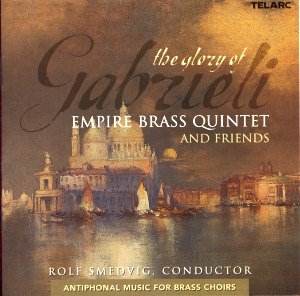The repertoire of original music for brass ensemble
is almost all fairly recent, so brass groups in search of an earlier
repertoire have to depend on arrangements. Renaissance polyphony has
always been a happy hunting ground, since the nature of the music and
the vocal ranges mean that transcription is virtually unnecessary; almost
the entire range of music written in that period can be played by brass
groups exactly as it is, and the results are invariably effective. The
Palestrina motet and in particular, I would say, the beautiful piece
by the little-known Bergamasque composer Giovanni Cavaccio, certainly
testify to this.
Besides, this was a period in which the possibilities
of instrumental music were being explored, although composers usually
left the actual scoring flexible. So, while nothing on the disc would
have sounded to its contemporaries exactly as it does here (these are
modern instruments and they do not pretend to be otherwise), the various
Canzone by Gabrieli, around which the programme is centred, were
all intended for instruments and we know that brass instruments were
in use in early 17th Century Venice. Some of these pieces
are originally for organ, such as the simple, brief but sublime Veni
Redemptor I by Thomas Tallis, which transcribes effortlessly to
the new medium without the need to change a note. In some ways the vocal-
and organ-derived pieces are the most attractive since the idea of writing
pieces for instruments was a new one and the composersí fascination
with hearing a phrase ricocheting down the aisle from one group to the
next was such that it hadnít occurred to them that one could have too
much of the effect.
Still, as long as you realise that nothing on this
disc sounds as it would have in the composersí own day, it is difficult
to imagine that the composers would not have been thrilled to hear their
work played with such security of ensemble and of intonation, as well
as brilliance and warmth as needed. The Empire Brass Quintet is one
of the best around, and they are also fortunate in their friends. The
sound of the whole group playing at full stretch is thrilling, aided
by a sumptuous recording in an acoustic which has a long enough reverberation
period to suggest an ecclesiastical setting.
If you donít have a disc of Renaissance music played
by brass on your shelves, then you need look no further than this one.
Christopher Howell


